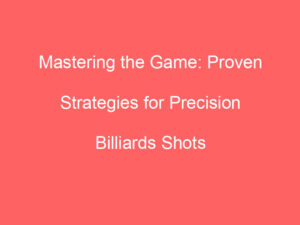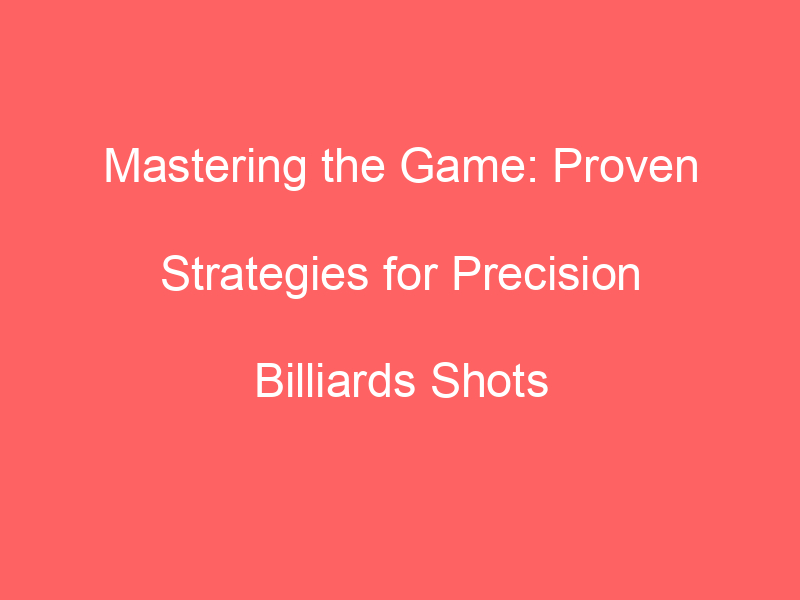
Introduction to the Science of Billiards
Billiards, a game enjoyed by many, is not just about skill and strategy. There’s a fascinating world of science hidden behind each shot and angle. This article will help you understand the basic physics involved in billiards and how science can improve your game.
-
- Understanding the basic physics involved in billiards
Billiards is a game of angles and speed, and understanding the science behind it can give you an edge over your opponents. The game is based on the principles of physics, particularly Newton’s laws of motion. When you strike a billiard ball, you’re applying a force to it. This force, according to Newton’s first law, sets the ball in motion. The direction and speed of the ball’s movement depend on the angle and strength of your shot.
Furthermore, when a moving ball hits a stationary one, the energy is transferred from the moving ball to the stationary one, causing it to move. This is an example of Newton’s third law, which states that for every action, there is an equal and opposite reaction. Understanding these basic principles can help you predict the outcome of your shots and plan your strategy accordingly.
-
- How science can improve your billiards game
Knowing the science behind billiards can significantly improve your game. For instance, understanding the concept of momentum can help you control the speed of the balls. Momentum is the product of mass and velocity. In billiards, all balls have the same mass, so the velocity or speed at which you strike the ball determines its momentum. A faster shot will transfer more momentum to the ball, causing it to move further.
Similarly, understanding angles can help you make more accurate shots. The angle at which a ball hits the rail determines the angle at which it will bounce off. This is based on the law of reflection, which states that the angle of incidence equals the angle of reflection. By understanding and applying this law, you can predict the path of the ball and make more strategic shots.
In conclusion, the science of billiards is a fascinating subject that can help you improve your game. By understanding the basic physics principles involved, you can make more accurate shots, plan your strategy better, and enjoy the game more. So the next time you pick up a cue, remember, you’re not just playing a game, you’re applying science!
The Physics of Fun: Billiards
Billiards is not just a game of skill and strategy, but also a fascinating display of physics in action. Let’s delve into the basic principles that govern this exciting game.
Understanding Billiards: The Basics
Before we can appreciate the advanced concepts of billiards, we need to understand the basics. Here are two fundamental aspects of the game:
-
- How the balls move and interact
When you strike the cue ball, it moves in a straight line towards its target. This is due to the force you apply with the cue stick. The direction in which the ball travels depends on the angle at which you hit it. When the cue ball hits another ball, it transfers some of its energy to that ball, causing it to move. This is known as the conservation of momentum.
-
- The role of friction and collisions in billiards
Friction plays a significant role in billiards. The friction between the ball and the table slows the ball down over time, eventually bringing it to a stop. When two balls collide, they push against each other, causing them to move in opposite directions. This is a result of Newton’s third law of motion, which states that for every action, there is an equal and opposite reaction.
Understanding these basic principles can help improve your game and give you a new appreciation for the science behind billiards. So, the next time you play, remember – you’re not just having fun, you’re also experiencing physics in action!
The Scientific Side of Billiards: Advanced Concepts
As we delve deeper into the science of billiards, we encounter more complex concepts. These concepts, while challenging, can significantly enhance your understanding and performance in the game. Let’s explore two of these advanced concepts: spin and trajectory, and the role of energy and momentum.
-
- Understanding Spin and Trajectory
Spin and trajectory are crucial elements in billiards. When you hit a billiard ball, you can control its spin, which in turn affects its trajectory, or path. By applying spin to the ball, you can make it curve in a certain direction, bypass other balls, or even hit multiple balls in one shot.
For instance, a top spin (hitting the ball above its center) will make the ball move forward after hitting another ball. On the other hand, a backspin (hitting the ball below its center) will make the ball move backward after the collision. This is a fascinating aspect of the science of billiards, demonstrating the power of spin and trajectory.
-
- The Role of Energy and Momentum in Billiards
Energy and momentum play a significant role in the game of billiards. When you strike a ball with the cue stick, you transfer energy and momentum to the ball. This energy and momentum are then transferred from one ball to another during collisions.
For example, if you hit the cue ball with a lot of force, it will move with high speed and energy. When it hits another ball, some of this energy and momentum are transferred to the second ball, causing it to move. The more energy you put into your shot, the more balls you can potentially move on the table.
In conclusion, understanding the scientific concepts of spin and trajectory, and energy and momentum, can greatly enhance your billiards game. By mastering these concepts, you can control the balls on the table more effectively and make more strategic shots. Remember, billiards is not just a game of skill, but also a game of science!
Physics in Sports: A Case Study of Billiards
Billiards, a popular game enjoyed by many, is not just about skill and strategy. It’s also a fascinating study of physics in action. By understanding the science behind billiards, you can improve your game and appreciate the complexity of this seemingly simple sport.
Science Behind Billiards: Key Takeaways
Let’s delve into the scientific principles at play in billiards and explore how you can use this knowledge to your advantage.
-
- How understanding physics can improve your game
Physics is the science of matter and energy and their interactions. In billiards, every shot you make involves physics. The angle at which you hit the ball, the force you apply, and the spin you create all have an impact on the ball’s trajectory and speed. By understanding these principles, you can predict the ball’s path more accurately and make more successful shots.
-
- Practical tips for applying scientific principles to billiards
Here are a few practical tips to apply physics to your billiards game:
-
- Angle of Incidence: The angle at which the cue ball strikes another ball will determine its path after impact. This is known as the angle of incidence. To improve your shots, try to visualize the angle of incidence before you make your move.
- Force and Speed: The force you apply to the cue ball will affect its speed. A harder hit will make the ball move faster, but it may also make it harder to control. Practice different levels of force to find the right balance for your game.
- Spin: Adding spin to the cue ball can change its direction after hitting another ball. This technique, known as “English,” requires practice but can give you more control over the game.
In conclusion, understanding the science behind billiards can not only improve your game but also deepen your appreciation for this sport. So, the next time you pick up a cue stick, remember – you’re not just playing a game, you’re conducting a physics experiment!
Billiards Game Theory: A Scientific Approach
Billiards, or pool, is not just a game of chance and skill. It’s also a game that involves a lot of science. By understanding the science behind the game, you can improve your strategy and become a better player. Let’s dive into the fascinating world of billiards game theory and see how a scientific approach can enhance your game.
Physics of Pool Games: Practical Applications
Physics plays a crucial role in pool games. It’s the science that explains how things move and interact, and it’s at work every time you strike a ball on the pool table. Let’s explore some practical applications of physics in pool games.
- How to use physics to plan your shots: Understanding the basic principles of physics can help you plan your shots more effectively. For instance, the law of conservation of momentum states that the total momentum before and after the collision of two balls remains the same. This means that if you hit a ball straight on, it will stop, and the other ball will continue with the same speed and direction. Knowing this can help you predict where the balls will end up after your shot.
- Understanding the impact of force and angle on ball movement: The amount of force you use and the angle at which you hit the ball can greatly affect its movement. A harder hit will make the ball move faster and further, while a softer hit will make it move slower and not as far. Similarly, hitting the ball at different angles will change its direction. For example, if you hit the ball on its right side, it will move to the left, and vice versa. This understanding can help you control the ball’s movement and improve your game.
In conclusion, understanding the science behind billiards can give you a competitive edge. So next time you play, remember that you’re not just playing a game, you’re also applying the principles of physics. Happy playing!
Scientific Explanation of Billiards: Beyond the Basics
Billiards is more than just a game. It’s a fascinating blend of strategy, skill, and science. In this section, we’ll dive deeper into the scientific principles that govern advanced billiards techniques.
Unveiling the Mystery: The Science Behind Advanced Billiards Techniques
Advanced billiards techniques may seem like magic to the untrained eye. However, they are all based on the fundamental principles of physics. Let’s explore these principles and how they apply to two key aspects of the game: bank shots and trick shots, and predicting ball paths.
-
- Understanding the physics of bank shots and trick shots
Bank shots and trick shots are some of the most exciting aspects of billiards. They involve bouncing the cue ball off the sides of the table, often in seemingly impossible ways. But there’s no magic involved – just physics!
When the cue ball strikes the side of the table, it bounces off at an angle equal to the angle at which it hit. This is known as the law of reflection. Trick shots take this principle to the next level, using spin and speed to manipulate the ball’s path after it bounces.
-
- How to calculate angles and predict ball paths
Predicting the path of a ball in billiards is all about understanding angles. When the cue ball strikes another ball, the direction in which the second ball travels depends on the angle of impact.
By understanding this principle, you can calculate the angle you need to hit the cue ball at in order to send the second ball in the desired direction. This involves a bit of geometry, but with practice, it becomes second nature.
In conclusion, the science of billiards is a fascinating topic that goes far beyond the basics. By understanding the physics involved, you can improve your game and impress your friends with your seemingly magical skills.
Conclusion: Embracing the Science of Your Billiards Game
Understanding the science behind billiards can not only improve your game but also deepen your appreciation for this classic sport. So, the next time you pick up a cue, remember: you’re not just playing a game. You’re engaging with the laws of physics.
Conclusion: Embracing the Science of Your Billiards Game
As we conclude this enlightening journey into the science of billiards, it’s clear that understanding the underlying principles can significantly enhance your enjoyment of the game. Let’s summarize the key points and provide some practical tips to help you apply this knowledge.
-
- How a scientific understanding can enhance your enjoyment of billiards
Understanding the science behind billiards can transform your game from a simple pastime into a fascinating exploration of physics and geometry. It allows you to predict ball movements, plan your shots strategically, and appreciate the complexity of the game. The thrill of executing a perfect shot using scientific principles is unmatched. It’s not just about winning; it’s about appreciating the beauty of the game at a deeper level.
-
- Summary of key points and practical tips
Throughout this article, we’ve explored various scientific principles that govern the game of billiards. We’ve looked at how physics and geometry play a crucial role in every shot, and how understanding these can improve your game. Here are some key points and practical tips:
-
- Physics of Fun: Billiards is a real-life demonstration of physics principles like momentum conservation and elastic collision. Understanding these can help you predict the outcome of your shots.
- Billiards Game Theory: Strategic planning and probability also play a part in billiards. Knowing when to play defensively and when to take risks can give you an edge in the game.
- Practical Tips: Practice visualizing the angles and trajectories before each shot. Use the diamond system to improve your bank and kick shots. Remember, practice is key to mastering these concepts.
In conclusion, embracing the science of your billiards game can not only improve your skills but also enhance your enjoyment and appreciation of this fascinating sport. So, pick up your cue, apply these principles, and see the difference for yourself!














